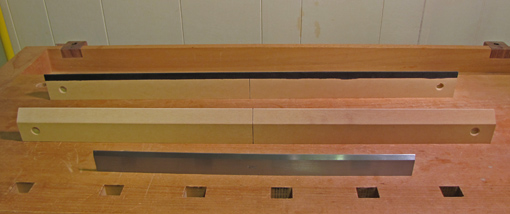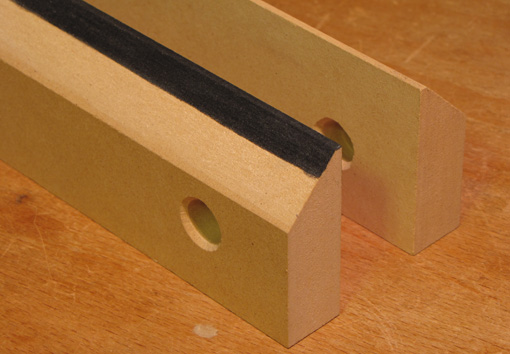
It can be argued that a straightedge is unnecessary. When using a handplane, for example, a woodworker can sense the flatness of a board from the bite of the blade and the shavings produced as the work progresses. As another example, the ultimate test of an edge-to-edge glue joint is how the boards meet each other rather than an external standard. You would, however, mostly have to just trust that your planes’ soles, tablesaw top, jointer beds, and so forth are accurately flat.
As a practical matter, a high quality straightedge is a fundamental reference tool that is very useful in the shop and is easy to acquire. I prefer factory-made metal straightedges, but wooden straightedges can be made in the shop to a very high standard.
Here’s a simple method:
Start with two pieces of a stable, fine-textured wood such as mahogany or cherry, quartersawn, flat, with straight grain, about 2″ wide, 18″ – 30″ long, and 3/8″ – 1/2″ thick. MDF will also do. Join the two pieces face to face by clamping, or by pinning with nails or dowels that are snug but removable. Bevel a pair of adjacent edges to make each 3/32″ – 1/8″ wide.
Now plane both the thick and the thin pairs of edges as flat as you can. I think the easiest way to accurately plane the edges is to shoot them. Put the plane on its side, clamp the pair of sticks on a flat board with a pair of edges overhanging, and plane away. Uncouple the pieces and check the edges against each other.
You can start off by simply ripping each piece on an accurately set up table saw and then go to the planing steps.
Because two edges are being planed together, they will have the same type of inaccuracy – concave or convex – at the same places. The inaccuracy will be effectively doubled when you place the edges against each other and compare them against a lighted background. [There is no realistic possibility of creating a falsely acceptable result by producing one concave edge which happens to mate with the other edge being symmetrically convex.] Work until you achieve whatever level of accuracy that you think is practical for your work.
You now have made two straightedges AND a pair of winding sticks!

I made the 30″ winding sticks, pictured above, from 3/4″ MDF. Only minimal planing was required to refine tablesawn edges. They’re good to about 0.001″ over their lengths. I use them only as winding sticks, which is another topic for another time.
For straightedges, I like steel and, in some cases, aluminum. A quality metal straightedge, such as a Starrett, is accurate to an extremely high tolerance and has the advantage of durability. I like the weight, contact feel, and affordability of a steel straightedge in lengths up to 24″. For longer ones, aluminum keeps the weight and cost down. Properly cared for, these tools will last a lifetime.
Next: a selection of straightedges and techniques for using them.


Thank you. I’ve been using some planed scrap as a straightedge for the past week after realizing how curvy all the cheap metal rulers and yardsticks I have are far from straight.
I saw an article somewhere that said to make the edges opposite the straight edge angled so that they are half the width at each end as they are in the middle so they don’t change shape as much w/ humidity changes – same idea as a coffin smoother plane body. Open grain along the whole length. Can’t do it w/ winding sticks since it is the side that sits on the board that are beveled, but might be worth doing for a straight edge. That combined with your writeup – time to make a straight edge and winding sticks. :)
Fitzhugh,
I do not think it is necessary to do that sort of shaping and I am skeptical that it would even help. It will also make what should be a comfortable, straighforward project considerably harder. I suggest use straight-grained, quartersawn wood, or, if you are concerned about stability, use MDF, which is essentially isotropic in this regard.
Winding sticks sit on their wider edges, just as I have pictured in the post.
By the way, as you can see, I blackened the top of one of the pair of winding sticks with a marker. This stick is the one placed closer to me in use. The more distant stick has moderate light shining on it. The contrast of the two edges makes any displacement easy to see.
Good luck with your project. I suggest that it is best to keep it simple.
Rob
Thank you for the interesting post on winding sticks Rob. I have been thinking of making some recently and shall follow your instructions.
I wanted to take the opportunity to thank you for all of the effort you have obviously put into this blog. I have just recently found you and have thoroughly enjoyed your posts which are full of excellent tips and advice. I have found your work and knowledge inspiring. Thank you.
Tom,
You’re very welcome and I appreciate the kind words. Let me know if you have any trouble with the project and I’ll be happy to help.
Rob